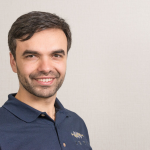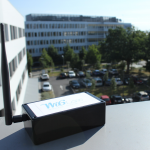Opti’Waves: microwaving ceramics
The start-up Opti’Waves, a direct spin-off from research conducted at Mines Saint-Étienne laboratories, offers new technology for firing technical ceramics. By using microwaves, this technology considerably reduces high-temperature firing times and the energy used to manufacture ceramics. Its target market? Dental prostheses. The start-up will present its industrial solution at CES 2019 Las Vegas with the delegation from IMT.
Having a dental prosthesis fitted is never a pleasant experience. The time required for this procedure makes it even more unpleasant. Whether several teeth need to be covered with a bridge, or a single molar needs replacing, you will have to undergo a series of appointments spanning at least one month. As the dentist assesses the best solution, takes dental impressions, fits a temporary prosthesis, then removes it and fits the final prosthesis, your jaw will repeatedly undergo great strain. The main reason for this little obstacle course your mouth must endure is the time the practitioner needs to produce the prosthesis, and have it fired at a high temperature.
“A type of chalk is condensed by heating it to approximately 1,500°C to create a ceramic prosthesis,” says Sébastien Saunier, a researcher in ceramic materials at Mines Saint-Étienne. The conventional firing process in very energy-intensive kilns —also called densification—lasts between 10 to 15 hours. Prosthetic technicians therefore wait until several parts can be produced in one operating cycle before using the kiln. Since dental practices often have three or four dentists, the volume of parts for patients cannot fill the kilns every day. There is therefore generally a wait time of approximately one week before the prosthesis can be delivered. “It is because of this time requirement that a temporary prosthesis must be fitted to prevent the gums from closing over again,” the researcher explains.
In light of this situation, Sébastien Saunier decided to use the results of his research to found the start-up Opti’Waves. To reduce the heating time for prosthesis densification, he developed a densification system using microwaves. The firing time was reduced from 10 hours to 40 minutes. “Conventional kilns are resistive, like traditional kitchen ovens: the heat comes from a resistor that heats the material from the outside,” Sébastien Saunier explains. “Firing the ceramic takes at least 10 hours. If the temperature rises too fast, the prosthesis will not be evenly fired, just like when you bake a pie too quickly: the outside is burnt and the inside isn’t cooked.”
The benefits of microwaves
With the microwave kiln, the firing takes place in the core. To ensure the prosthesis is evenly fired, Opti’Waves developed a patented bowl system. The parts are placed in this system and the bowl distributes the heat over the entire material. “This the culmination of the expertise we have been developing for ten years in the laboratories of Mines Saint-Étienne on firing ceramics using microwaves,” the researcher explains. Using bowls of different shapes and sizes, the Opti’Waves kiln can be used to produce crowns, bridges and even entire jawbones. The icing on the cake: the reduced firing time directly affects the kiln’s energy consumption. “The microwave kiln already uses slightly less energy than a conventional kiln, but the savings is directly proportional to reduced operating time.”
The start-up’s product therefore allows prostheses to be produced more quickly, since practitioners no longer need to wait several days before starting a firing cycle that lasts one workday. This benefit will change the organization of the dental prosthesis market. “The manual dental impression process is increasingly being replaced by intraoral scanners. The digital file is generated almost instantly and can immediately be emailed to countries in Eastern Europe or Asia,” says Sébastien Saunier.
In these countries with lower labor costs, the high volume of requests enables them to quickly fire several dozen prostheses at once. They are then sent to practitioners in France, with a total time equivalent to or even shorter than what a small laboratory of prosthetic technicians could accomplish, considering the wait times needed to fill the kiln for a few patients. “Our microwave kiln allows us to directly compete with this production outsourcing and bring prosthesis manufacturing back to France,” observes the researcher and entrepreneur.
Opti’Waves will participate in CES 2019 in Las Vegas from January 8 to 11. The young company will again present its kiln before putting it on the market this spring. “There is already a high demand among prosthetic technicians,” says Sébastien Saunier. This early success is also due to the kiln being so easy to use. In addition to its performance, it comes with a range of software that makes life easier for prosthetic technicians: “All they need to do is enter the number of parts they want to fire and push the button.”
The researcher sees the expertise they have developed in the dental prosthesis market as a springboard. “Our core business is technical ceramics, which is present everywhere: in the aeronautics, automotive, defense and luxury industries…” Opti’Waves makes no secret of its ambitions to apply its microwave technology in other business sectors, in which companies are also facing energy challenges. In conclusion, Sébastien Saunier sums it up quite simply: “our objective is to industrialize technical ceramic production using microwaves.”





Leave a Reply
Want to join the discussion?Feel free to contribute!